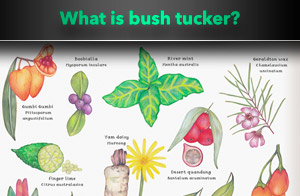7 popular traditional foods
If you live in Australia or you've visited for an extended period, chances are you've heard the term 'bush tucker'.
Bush tucker is a word used to describe traditional indigenous foods, and it's been an integral part of Aboriginal culture for thousands of years. It's actually still enjoyed by many Indigenous Australians today, and bush tucker is slowly making its way into the mainstream.
What exactly constitutes bush tucker though? In this article, we'll explore 7 of the most commonly eaten traditional Aboriginal foods that can be found in many areas around Australia.
The definition of bush tucker
Australian bush food, or bush tucker as it's lovingly called, refers to native ingredients from Australia that Aboriginal Australians once relied on (and still do) for survival in our harsh climate.
They would forage for herbs, spices, fruits, seeds and nuts, cultivate plants and tubers or hunt animals like kangaroo, emu, crocodile and witchetty grubs. With their incredible knowledge of the surrounding flora and fauna, Indigenous Australians were able to thrive for thousands of years.
The different types of bush tucker
Bush coconut
The bush coconut is an intriguing amalgamation of animal and plant.
These unique coconuts exclusively grow on desert bloodwood eucalypt trees (Corymbia terminalis) and form through a symbiotic relationship between the tree and an adult female scale insect.
When the insect attaches itself to the tree, the tree responds by creating a protective coating or gall around it. This gall becomes the bush coconut, which is then harvested from the host tree and cracked open to reveal an edible flesh and scale insects.
Both provide a rich protein source for humans and other animals. The name bush coconut originates from the resemblance of the white flesh to that of a coconut, both in appearance and taste.
Kangaroo
Kangaroo meat is lean and affordable, making it a convenient choice for cooking. With less than 2% fat and heart-friendly omega-3s, it's also an incredibly healthy option when it comes to meat.
Additionally, kangaroo meat is an excellent source of iron, zinc and several essential B-group vitamins including riboflavin, niacin, vitamin B6 and vitamin B12. Throughout history, kangaroos have played a vital role in the survival of Australia's indigenous peoples.
For tens of thousands of years, these animals were hunted for their meat and skins. Even after the arrival of Europeans in the late 18th century, kangaroo meat remained a crucial resource for their sustenance.
Finger lime
The finger lime, also known as caviar lime, got its name for a good reason! Resembling a long finger, this edible lime is filled with tiny pearls that burst with a flavour similar to regular limes.
It has become popular in Australia's finest restaurants, adding a zesty touch to dishes, desserts and cocktails. Finger limes are a vital food source, packed with folate, vitamin E, vitamin C and potassium.
Emu
The emu was an important food source for the Aboriginal people. It was also used in ceremonies and medicine. The name "emu" comes from the Portuguese word "Ema", which means crane or large bird.
When cooking emu meat, it's important to cut it against the grain to prevent it from becoming shorter. For maximum tenderness and flavor, serve the meat slightly rare, not well done!
When grilling, cook the meat quickly over high heat in a pre-heated hot pan and remove it from the heat as soon as the juices start to rise.
Witchitty grub
These worm-like creatures feed on the roots of the witchetty bush and the wood of black wattle trees. They are commonly eaten raw or roasted and are a valuable source of high-protein insect food in the desert.
When eaten raw, the liquid center of the witchetty grub has a nutty and almond-like flavour. When cooked, the insides turn light yellow and the outer skin becomes crispy like roast chicken.
Some compare the taste of cooked grubs to scrambled eggs or popcorn.
Quandong
Australia is home to three fascinating quandong fruit varieties: the desert quandong, bitter quandong and blue quandong. Among them, the desert quandong, also known as the sweet quandong and desert peach, is the most delicious.
The desert quandong tree, known for its shiny red fruit and cream-colored flowers, thrives in arid conditions. For thousands of years, it has been a vital food source for Australian Aboriginals and early European settlers used the fruit to make jams.
The fruit, whether fresh or dried, is prized for its long shelf life... with the ability to last up to 8 years.
Bunya nut
No bush tucker list is complete without the bunya nut!
The bunya pine tree (Araucaria bidwillii) is one of the tallest and oldest species in Queensland, growing up to 30 metres tall and living for over 500 years.
Bunya nuts are seasonal, with harvesting occurring once every 2 or 3 years when cone's open in late summer and early autumn. When the nuts (seeds) are fresh, they can be consumed raw. However, boiling the seed pods to extract the nut makes the process much easier.
Afterwards, the nuts can be roasted, sliced or pureed for use in desserts, savory dishes and spreads. Additionally, the nuts can be ground into flour and incorporated into a variety of doughs.
So, will you be trying any of these traditional Aboriginal foods? Not only does bush tucker provide great health and nutritional benefits, but it's also a way to experience the fascinating culture of Australia's Indigenous people.
We hope you enjoy your next bush tucker meal as much as you enjoy spinning our range of epic pokies!
Play with Uptown Pokies today!
Deposit $30+
Get 111% Match Bonus + 111 Spins on Top!
Redeem Coupon: BUSHTUCKER111
Terms & Conditions:
BUSHTUCKER111 holds 25x roll over + 5x on spins winnings, available until the 15th of October 2023, redeemable 2x. Standard bonus terms apply. Free spins game: Meerkat Misfits
